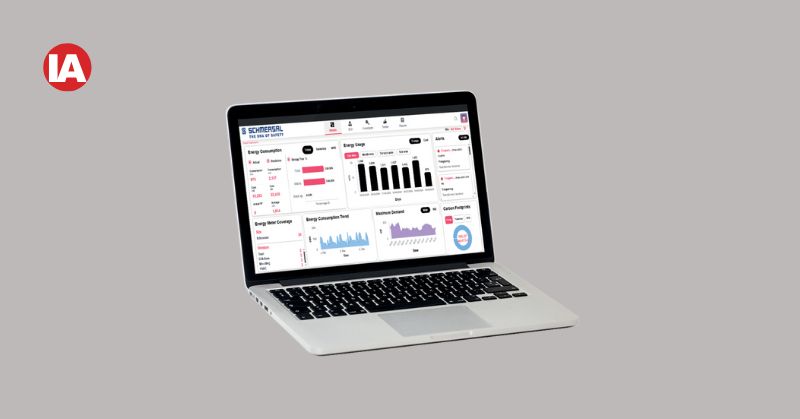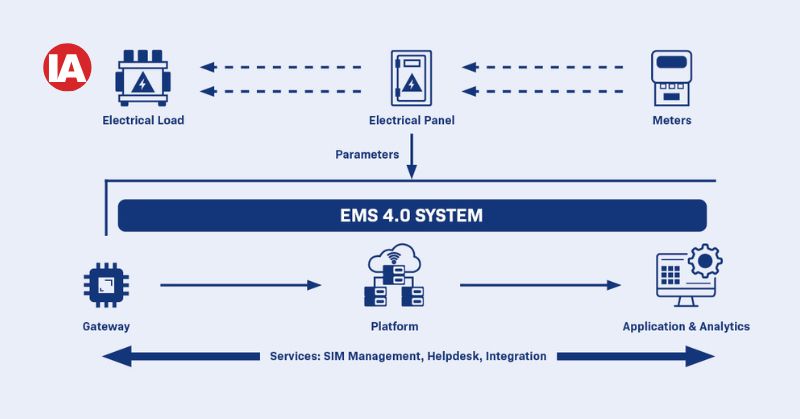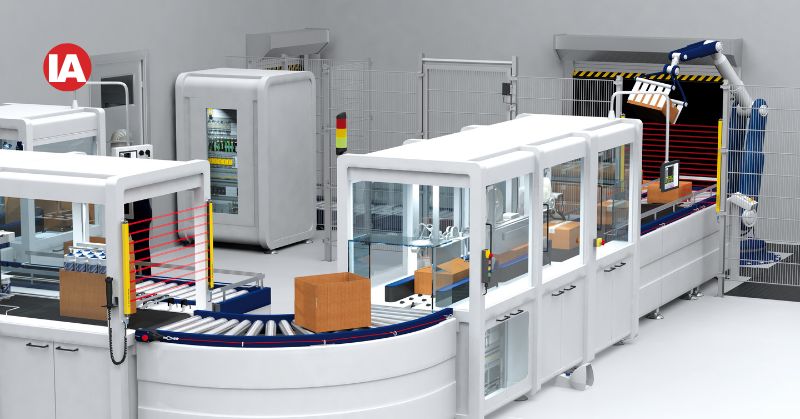
Energy Management as an IIoT Solution
Efficient energy management is more crucial than ever amid soaring electricity costs and increasing environmental concerns. Schmersal Group’s Energy Management Solution 4.0 (EMS 4.0) offers a groundbreaking IIoT-supported platform that integrates real-time energy data with production KPIs like Overall Equipment Effectiveness (OEE). With plug-and-play modularity, comprehensive reporting, and edge-level analytics, EMS 4.0 empowers businesses to optimize energy consumption, enhance operational efficiency, and meet ESG reporting requirements. Discover how Schmersal’s innovative technology is transforming energy management for sustainable industrial operations.
![[object Object]](https://admin.industrialautomationindia.in/storage/articles/article-yafcEmIeNnhKtD9zjsxiBydK6Irwry1n6HqmUnts.jpg)
What is scarce, expensive and essential needs to be ‘managed’, which is why energy management is the current watchword.
Following the dramatic rise in electricity prices, energy consumption is becoming an increasingly important variable that needs to be carefully influenced. Energy management systems have long offered a solution. But only now is there an IIoT-supported application for the capture and optimisation of energy consumption, which – as in many other areas of digitalisation – promises considerable added value.

and broken down into its constituent elements.
EMS 4.0: Comprehensive database for optimising energy consumption
tec.nicum, the Schmersal Group’s newly established service division (see text box), has developed a modular solution in the form of the ‘Energy Management Solution 4.0’ or EMS. It is part of a comprehensive IIoT platform whose task is to bring transparency to production and provide users with a comprehensive database for far more than just energy consumption.
As a plug-and-play module within this solution, EMS 4.0 makes it easy to set up and assign energy meters. A dashboard visualises the consumption of all systems and their development. A range of evaluation functions allows for the generation of detailed reports on energy consumption, including to individually defined parameters. Limit values can be defined and an (alarm) message emitted if these values are exceeded.
This provides users with a solid basis for energy efficiency initiatives, allowing them to test and evaluate the efficacy of individual measures and to prepare the data for CSR reporting, something that is already compulsory for larger companies across the EU. This requirement will gradually be rolled out to smaller companies.
Managing energy – A task for today and tomorrow
What is scarce, expensive and essential needs to be ‘managed’, which is why energy management is the current watchword.
Appropriate IT tools are available and are frequently used. These use energy meters to capture consumption (for electricity, gas, compressed air, etc.), which users can then trace to individual areas of production, systems or even production quantities.
These systems are especially useful when they are fully integrated into the organisation’s or production department’s data environment, and not operated as stand-alone devices.
This way, the ‘adjustment screws’ for targeted optimisation and clear allocation of energy costs to individual products or production steps will be transparent (in the best case scenario).
Energy efficiency as a KPI factor
Where EMS 4.0 differs from other energy management systems is in its integration into the comprehensive IIoT concept developed by the Schmersal Group, which it makes available to its customers as a platform.
This IIoT platform was essentially developed for the task of ‘Safety as a Service’ and for IIoT-supported service concepts (condition monitoring and predictive maintenance), but as it captures and analyses wide-ranging (production) data, it is also suitable as a basis for energy management.

and forwarded for further processing. EDGE gateways collect the
data of all parameters that are forwarded to the platform.
The data are stored and processed on the
Schmersal IIoT platform and forwarded to the EMS 4.0.
Task: To capture overall equipment effectiveness (OEE)
And because calculating KPIs is also part of the IIoT concept developed by tec.nicum (as are condition monitoring and predictive maintenance), energy efficiency can be related to KPI-relevant data. More specifically, as the IIoT platform captures central KPIs for production, energy-related data may be incorporated into these KPIs, something which applies to the overall equipment effectiveness (OEE) KPI, for example. It captures the productivity and effectiveness of a production system, thereby allowing systems (in the same or in different production facilities of an organisation) to be compared, as well as targeted optimisation of this KPI.
First usage example: Production of household appliances
The first user of the Schmersal’s ‘Energy Management Solution 4.0’ is making use of exactly this option. Plant management at the Indian production facility of a global manufacturer of household appliances had set itself the goal of increasing energy efficiency in production year on year, with a 2% to 5% reduction in energy consumption in relation to production volume each year – and a matching positive impact on the carbon emissions from the site (which are also accurately recorded).
The company was looking for a comprehensive, IT-supported solution to bring transparency to the current status, while also allowing KPIs such as OEE to be captured. The third requirement was for the database to document progress – in part for international ESG reporting.
The site’s managers approached the Schmersal Group’s IIoT Global Competence Centre, which also happens to be based in India, with their list of requirements. The Competence Centre was already planning the market launch of the ‘Energy Management Solution 4.0’ and was able to use the manufacturer as an initial ‘use case’.
Hardware: Failsafe edge solution
When selecting hardware components, particular care was taken to ensure that components are able to maintain communication with the web server for a defined period of time, even if there is a power failure. The data captured from machinery and drive systems and recorded by energy meters and other sensors are initially collected at edge level, i.e., in the immediate vicinity of production, and analysed in real time. 4G Modbus IoT gateways are just one of the devices used for this.
This means that users have access to almost current data at all times, which can also be used directly to control the energy supply and generation (solar systems, generators, etc.).
Comprehensive reports are also generated in parallel to document the progress made in reducing energy consumption and carbon emissions.

platform whose task is to bring transparency to production
and provide users with a comprehensive database
for far more than just energy consumption.
The benefits of digitalisation – Fusing energy and production data
The household appliance manufacturer is fully satisfied with this solution: the personnel effort required to capture and analyse energy consumption has been drastically reduced and the OEE key figure has improved substantially. Operational safety has also been improved with close monitoring of critical energy consumers and generators.
The same also applies to energy distribution systems. Irregularities are largely identified
in real time and reported immediately, e.g., by SMS text message, to the person responsible.
Transparency even goes so far as to capture the energy consumed by each product manufactured – that is to say individually, for every single household appliance that comes off the production line. To ensure this, the energy data must be related to the production data of the digital plant. This is also ensured by Schmersal’s IIoT platform.
Technical article from: Schmersal India
First published: www.digital-factory-journal.de
Authors: Volker Heinzer and Sachit Mohan
Email: info-in@schmersal.com
New Responsibilities For tec.nicum: Energy Management and ‘Safety As A Service’
The Schmersal Group has recently restructured its service, consulting and engineering offerings and bundled them into an independent company: tec.nicum – Solution & Services GmbH. The division operates worldwide and currently employs 162 people, most of whom are technicians and certified functional safety engineers.
More important than the new structure is the significantly expanded range of services, not only but also in the areas of digitalisation and software, where tec.nicum offers new solutions that include a tool for carrying out risk assessments, as well as new digital services such as cloud solutions, IIoT applications and energy management tools.
The ‘backbones’ of these services include a stable IIoT platform that ensures reliable communication between all participants (from sensors and display systems to gateways, servers and the cloud). This tec.nicum-developed platform has proven its value not just in the IIoT-supported energy management system presented here, but in other applications as well. tec.nicum experts are already working on the next step, which will see safety data collected, transmitted and analysed by the platform. This creates the conditions not just for fully new, comprehensive services, but for a new business model as well – ‘Safety as a Service’.